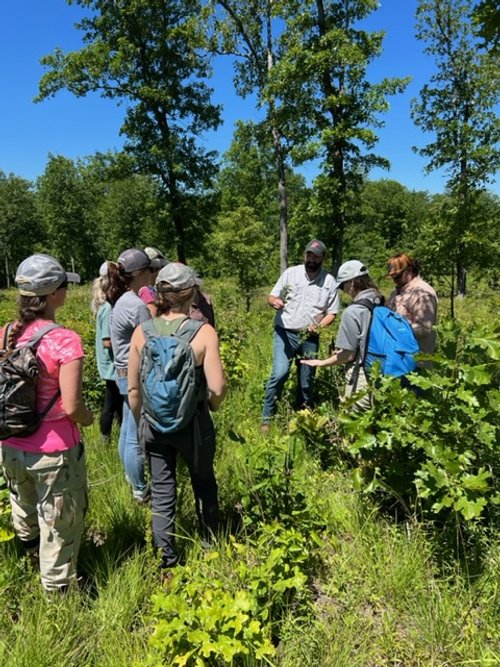On June 18, Artemis Sportswomen, the Tennessee Wildlife Federation, and the Southeastern Grasslands Institute hosted a field trip to Catoosa Wildlife Management Area for women in conservation. The purpose of the field trip was to learn about the conservation and importance of Tennessee’s vanishing savannas and other grassland ecosystems.
Field trip participants learned how to read the story of the land by looking for storytelling/indicator species in upland forests, along the roadsides, and in the restored oak-pine savannas. Along the way, Dr. Dwayne Estes, Executive Director of the Southeastern Grasslands Institute at Austin Peay State University (APSU), and APSU Graduate Research Assistant Brittney Georgic shared the importance of the savanna ecosystems to biodiversity, hunting, recreation, and ecosystem services.
Before the savanna restoration project, which began in the 2000s, the uplands at Catoosa were artificially dense closed-canopy forests that had become closed due to many decades of fire suppression. With canopy thinning followed by prescribed burns, the plant diversity exploded from about 30 species to more than 300 wildflowers, grasses, and shrubs. Much of this diversity came from an unexpected underground treasure trove of buried seeds and rhizomes that no one knew was there.
Restoring the plant communities to conditions like those that existed in the 19th century is having positive benefits. The wide variety of native plant species provides habitat, food, and cover for many animals, particularly savanna-dependent birds, the golden mouse, and rare insects like the Frosted Elfin Butterfly and Rattlesnake Master Borer Moth. A half-dozen rare species of plants have also been found in the savannas.
“The Catoosa Wildlife Management Area is a special place, not just because of the amazing diversity of plants and animals, but also because in the span of about a decade they’ve been able to restore a forgotten ecosystem that most people didn’t even know existed,” Estes said. “I think that speaks volumes about how we can better manage our public lands and curb biodiversity loss.”
The field trip was part of a two-week conservation advocacy training program hosted by Artemis Sportswomen and the Tennessee Wildlife Federation. The goal of the training program is to expand awareness of conservation in Tennessee and to empower people to advocate for conservation. This trip was one of five key learning sessions from Artemis and Tennessee Wildlife Federation on conservation advocacy which also covered government structure, storytelling, writing and public speaking.
“Collaboration is critical to advancing conservation in our state. We are so pleased the Southeastern Grasslands Institute partnered with us to bring habitat conservation to life,” said Kevin Botts, Director of Policy, Tennessee Wildlife Federation. “It was incredible to see how this energized an already passionate group of sportswomen.”
The Tennessee Wildlife Federation is an independent nonprofit committed to conserving our state’s wildlife and natural resources and that brings together hunters, anglers, wildlife watchers, and other outdoor enthusiasts. It is one of the largest and oldest conservation organizations in Tennessee and is involved in stewardship, habitat conservation, youth engagement, and public policy.
Artemis Sportswomen is a National Wildlife Federation Program that consists of a network of sportswomen who have a strong interest in advocating for conservation and wildlife.
The Southeastern Grasslands Institute is a grasslands-focused research, conservation, and education branch of Austin Peay State University’s Center of Excellence for Field Biology. With more than 50 graduate and 125 undergraduate degree paths, Austin Peay is a major regional provider of higher education. The Southeastern Grasslands Institute works to conserve, restore, and promote native grasslands throughout the Southeast.
The Catoosa Wildlife Management Area is located on the Cumberland Plateau in Cumberland and Morgan Counties of eastern Tennessee. It consists of a mixture of forested slopes and gorges, beautiful rocky streams, extensive upland oak-pine forests and woodlands, scattered sandstone glades and boggy seepage wetlands, and more than 5,000 acres of restored oak-shortleaf pine savannas. Catoosa Wildlife Management Area is managed by the Tennessee Wildlife Resources Agency and is open to the public.

